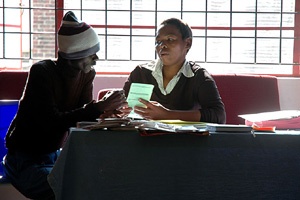South Africa: First nurses trained to initiate MDR-TB treatment
South Africa will increasingly move towards nurse-initiated treatment for multidrug-resistant tuberculosis (MDR-TB) in the next five years, and a programme in KwaZulu-Natal Province, which has a high HIV/TB burden, is already training nurses to manage MDR-TB patients.
Faced with a chronic shortage of doctors, South Africa moved to
nurse-initiated antiretroviral treatment (NiMart) in April 2010.
Now, government plans to roll out nurse-initiated MDR-TB
treatment, and to make it and NiMart available at all primary
healthcare, antenatal, TB and mobile outreach clinics by 2016,
according to the National Strategic Plan on HIV, STIs [sexually
transmitted infections] and TB.
In KwaZulu-Natal province, a programme run by the US-based Johns
Hopkins University has already trained at least 70 nurses in
MDR-TB treatment initiation and care.
Preliminary research, released at the South African TB
Conference, in Durban, showed that outcomes in patients
initiated and monitored by these nurses were as good, and
sometimes better, than those under a doctor’s care.
The research presented by Dr Jason Farley of Johns Hopkins
compared the early outcomes of about 90 MDR-TB patients who had
been assigned to one of two groups. Those in poorer health, or
who were HIV-positive with low CD4 counts (indicating a weakened
immune system) were initiated and monitored by a doctor. Nurses
initiated those in better health, or who were HIV-positive but
with higher CD4 counts.
Culture conversion rates - the number of patients with two
consecutive TB-free sputum cultures - were the same in both
groups, but nurse-initiated and -managed patients tended to
reach culture conversion about two weeks sooner than those under
a doctor’s care, and were also more likely to be routinely
checked for adverse reactions to their drugs.
About a third of all MDR-TB patients diagnosed in 2011 never
received treatment, according to figures presented by Dr Norbert
Ndjeka, director of Drug-resistant TB, TB and HIV at the South
African National Department of Health.
Before the publication of new guidelines for drug-resistant TB
in August 2011, MDR-TB patients could only be initiated on
treatment after being admitted to a TB hospital, but a
lack of beds
in these facilities contributed to long MDR-TB treatment waiting
lists, Ndjeka said.
How they do it
Johns Hopkins has adapted a chronic care model in its training
programme for nurses, Farley said. It is centred on five key
aspects, including patient self-management strategies, community
resources, and treatment delivery. The model has been tested in
more than 500 health facilities worldwide.
Nurses receive a one-week intensive, case-based course in the
theory of MDR-TB and its treatment before starting three months
of clinical mentoring, including training in physical
examinations, a one-week refresher course on HIV, and six weeks
of in-service training in MDR-TB wards at major hospitals.
According to Farley, who presented information on the programme
at the South African TB Conference, the training has exposed
gaps in the current training of primary healthcare nurses - for
instance, many have not been trained to interpret audiology
reports.
Kanamycin, an injected drug that forms part of South Africa’s
MDR-TB treatment regimens, must be administered to adults up to
three times a week for six months. These injections are not only
painful but can cause permanent hearing loss, leaving patients
with the horrible choice of being dead or deaf, said Dr. Helen
Cox of the international humanitarian medical organization,
Médecins Sans Frontières (MSF).
MSF recently installed audiology booths in Khayelitsha, a
township outside Cape Town to help monitor potential hearing
loss in MDR-TB patients. A lay health worker was trained to do
baseline tests to establish hearing capability when the patient
starts the treatment, and an audiologist comes in to conduct
follow-up testing on designated days each month.
Clinics in KwaZulu-Natal’s rural Udu district, where
Farley works, have begun using tele-audiology to send hearing
tests electronically to audiologists in larger centres for
interpretation.
Johns Hopkins has also added laboratory monitoring and
evaluation. “When lab results are obtained, often there
are abnormalities. [A nurse’s] initial response is
usually, ‘refer’,” Farley said. “Within
the MDR-TB programme, we need to be able to triage, or determine
what we can manage, and refer as appropriate.”
Ntombasekaya Mlandu was the first nurse in South Africa to begin
initiating patients on MDR-TB treatment. She said her NiMart
training on how to initiate and monitor ARV patients did not
prepare her for MDR-TB.
“The only thing we knew in the NiMart is that when you
faced even the slightest problem you would refer the patient to
the hospital,” Mlandu told IRIN/PlusNews. “Now, with
MDR-TB, most of the blood results I can manage… and if I
do have a problem, there is a doctor to assist me.”
Following training, the nurses reported that they felt more
confident about managing MDR-TB, but Farley said their
confidence levels had probably risen because they gained
real-world experience.
Mlandu had never worked in an MDR ward when she was selected for
the Johns Hopkins programme. Now, she says, “Even if you
wake me up in the middle of the night and say, ‘What is
[the MDR-TB drug] ethionamide doing to the client?’ I will
tell you that if the thyroid is enlarged, you better take the
thyroid-stimulating hormone [levels] right there and
then.”
PlusNews
http://www.irinnews.org/Report/95681/SOUTH-AFRICA-First-nurses-trained-to-initiate-MDR-TB-treatment


